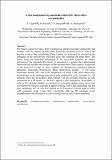| dc.contributor.author | Vigliotti, A. | |
| dc.contributor.author | Ronan, William | |
| dc.contributor.author | Baaijens, F.P.T. | |
| dc.contributor.author | Deshpande, V.S. | |
| dc.date.accessioned | 2016-08-09T13:42:51Z | |
| dc.date.issued | 2015-09-04 | |
| dc.identifier.citation | Vigliotti, A., Ronan, W., Baaijens, F. P. T., & Deshpande, V. S. (2016). A thermodynamically motivated model for stress-fiber reorganization. Biomechanics and Modeling in Mechanobiology, 15(4), 761-789. doi: 10.1007/s10237-015-0722-9 | en_IE |
| dc.identifier.issn | 1617-7940 | |
| dc.identifier.uri | http://hdl.handle.net/10379/5934 | |
| dc.description.abstract | We present a model for stress-fiber reorganization and the associated contractility that includes both the kinetics of stress-fiber formation and dissociation as well as the kinetics of stress-fiber remodeling. These kinetics are motivated by considering the enthalpies of the actin/myosin functional units that constitute the stress fibers. The stress, strain and strain rate dependence of the stress-fiber dynamics are natural outcomes of the approach. The model is presented in a general 3D framework and includes the transport of the unbound stress-fiber proteins. Predictions of the model for a range of cyclic loadings are illustrated to rationalize hitherto apparently contrasting observations. These observations include: (1) For strain amplitudes around 10 % and cyclic frequencies of about 1 Hz, stress fibers align perpendicular to the straining direction in cells subjected to cyclic straining on a 2D substrate while the stress fibers align parallel with the straining direction in cells constrained in a 3D tissue. (2) At lower applied cyclic frequencies, stress fibers in cells on 2D substrates display no sensitivity to symmetric applied strain versus time waveforms but realign in response to applied loadings with a fast lengthening rate and slow shortening. (3) At very low applied cyclic frequencies (on the order of mHz) with symmetric strain versus time waveforms, cells on 2D substrates orient perpendicular to the direction of cyclic straining above a critical strain amplitude. | en_IE |
| dc.description.sponsorship | A.V. and V.S.D. acknowledge the Royal Society for supporting A.V. through a Newton International Fellowship. | en_IE |
| dc.format | application/pdf | en_IE |
| dc.language.iso | en | en_IE |
| dc.publisher | Springer Verlag | en_IE |
| dc.relation.ispartof | Biomechanics and modeling in mechanobiology | en |
| dc.rights | Attribution-NonCommercial-NoDerivs 3.0 Ireland | |
| dc.rights.uri | https://creativecommons.org/licenses/by-nc-nd/3.0/ie/ | |
| dc.subject | Mechano-sensitivity | en_IE |
| dc.subject | Actin/myosin contractility | en_IE |
| dc.subject | Stress fibers | en_IE |
| dc.subject | Cytoskeleton | en_IE |
| dc.subject | Mechanical engineering | en_IE |
| dc.subject | Biomedical engineering | en_IE |
| dc.title | A thermodynamically motivated model for stress-fiber reorganization | en_IE |
| dc.type | Article | en_IE |
| dc.date.updated | 2016-07-29T14:58:04Z | |
| dc.identifier.doi | 10.1007/s10237-015-0722-9 | |
| dc.local.publishedsource | http:/dx.doi.org/10.1007/s10237-015-0722-9 | en_IE |
| dc.description.peer-reviewed | peer-reviewed | |
| dc.contributor.funder | |~| | |
| dc.description.embargo | 2016-09-04 | |
| dc.internal.rssid | 11156645 | |
| dc.local.contact | William Ronan, Mechanical Engineering, School Of Engineering, Nui Galway. Email: william.ronan@nuigalway.ie | |
| dc.local.copyrightchecked | No | |
| dc.local.version | ACCEPTED | |
| nui.item.downloads | 332 | |


